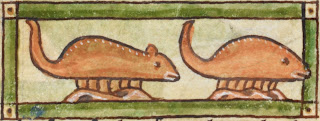cacao - Uto-Aztecan via Spanish (Uto-Aztecan is a fairly large language family that includes languages stretching from Nahuan (Aztecan) in southern Mexico to Northern Paiute in California and Nevada.)
maize - Arawakan via Spanish (Arawakan is a widespread language family spoken in South America and the Caribbean, including languages of Brazil, and also Taino, the first American language encountered by Europeans.)
papaya - Arawakan via Spanish
quinoa - Quechua via Spanish (Quechua is a language family of the Andes, including the language of the Inca Empire.)
squash - Algic (The Algic family includes the Algonquian languages and was spoken along the northeast coast of America and across areas of northern Canada.)
chocolate - Uto-Aztecan via Spanish
jicama - Uto-Aztecan via Spanish
tomato - Uto-Aztecan via Spanish
cashew - Tupi-Guarani via French (Tupi-Guarani is a language subfamily in South America.)
tapioca - Tupi-Guarani via Portuguese
chia - Uto-Aztecan via Spanish
mole - Uto-Aztecan via Spanish
chipotle - Uto-Aztecan via Spanish
guacamole - Uto-Aztecan via Spanish
cayman - Cariban via Spanish (Cariban languages are spoken along the northern coast of South America.)
manatee - Cariban via Spanish
toucan - Tupi-Guarani via French
condor - Quechua via Spanish
moose - Algic
opossum - Algic
raccoon - Algic
skunk - Algic
guanaco - Quechua
jaguar - Tupi-Guarani
mangrove - Cariban via Spanish
caribou - Algic via French
peccary - Cariban
anole - Arawakan via French
mesquite - Uto-Aztecan via Spanish
puma - Quechua via Spanish
margay - Tupi-Guarani via French
tamarin - Cariban via French
axlotl - Uto-Aztecan
tapir - Tupi-Guarani
quetzal - Uto-Aztecan via Spanish
chipmunk - Algic
saguaro - Uto-Aztecan
piranha - Tupi-Guarani via Portuguese
savannah - Arawakan via Spanish
pampas - Quechua via Spanish
bayou - Muskogean via French (Muskogean languages, as this borrowed word implies, are spoken in the southeastern United States.)
cenote - Mayan
quipu - Quechua via Spanish
cannibal - Cariban via Spanish
maraca - Tupi-Guarani via Portuguese
hammock - Cariban via Spanish
guano - Quechua via Spanish
moccasin - Algic
tomahawk - Algic
wigwam - Algic
tepee - Siouan (The Siouan languages are in the Great Plains area of central North America.)
kayak - Eskimo-Aleut (You can probably deduce that the Eskimo-Aleut languages are native to the far north of North America.)
totem - Algic
toboggan - Algic via French
igloo - Eskimo-Aleut
kachina - Uto-Aztecan
inukshuk - Eskimo-Aleut
[Pictures: Cacauate, wood block print from La historia del Mondo Nuovo by Girolamo Benzoni, 1565 (Image from Wikimedia Commons);
The Manatee, woodcut from Sea Fables Explained by Henry Lee, 1883 (Image from here);
Skinning Caribou Inside the Iglu, linocut by Janet Kigusiuq, 1982 (Image from Inuit.net).]














